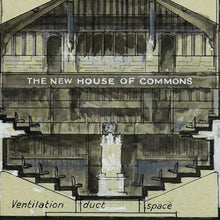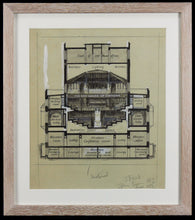George Horace Davies - The New House of Commons
- Regular price
- £1,250
- Sale price
- £1,250
- Regular price
-
- Unit price
- /per
Adding product to your cart
Overall: 42cm (16.5in) x 37cm (14.5in)
Watercolour heightened body colour, pen, ink and pencil, on board. Cross section view of the chamber. Editor’s notes in lower margin. Unsigned. Image: 32cm x 26.5cm.
In October 1943, following the destruction of the Commons Chamber by incendiary bombs during the Blitz, the Commons debated the question of rebuilding the chamber. With Winston Churchill's approval, it was decided to retain the adversarial rectangular pattern instead changing to a semi-circular design favoured by other legislative assemblies. Churchill insisted that the shape of the old Chamber was responsible for the two-party system which is the essence of British parliamentary democracy: 'we shape our buildings and afterwards our buildings shape us.’
Read more
Clearance of the site began in May 1945, and the foundation stone of new Chamber was laid in 1948. Designed by Giles Gilbert Scott along similar lines to the old, its small size (containing only 427 seats for 646 MPs) and confrontational layout were retained to keep debates lively and robust but also intimate. The new Commons Chamber was first used on 26 October 1950.
George Horace Davis (1881-1963) was born in Kensington, London, and was educated at the Ealing School of Art. He began his career as a freelance artist while acting as an assistant to his father, who described himself as a ‘hot water engineer’. During the First World War Davis joined the Royal Flying Corps and used his diagrammatic skills to to produce aerial manoeuvre diagrams for pilot training. He rose to become officer-in-charge, Aerial Diagrams and worked in the RFC’s T5 Section in South Kensington. This work was important enough for Davis to be featured in the 19 May 1919 issue of Flight magazine.
He was also commissioned by the Imperial War Museum to paint two scenes of aerial combat. After the war he continued as a staff artist for The Sphere and The Graphic, specializing in military and maritime subjects, covering everything from searchlights to ocean liners. In 1923 he started his 40-year collaboration with the Illustrated London News, and began to produce his trademark cutaways, close-ups and sequential images of across a broad range of subjects. His work often occupying single and double page spreads became widely known. Also in the 1930s Davis illustrated at least one advertising poster for the Holland America Line showing their then latest SS Statendam ocean liner, while ‘The Latest In Lightships’ appeared in D.C. Thomson’s 1937 ‘Skipper Book For Boys'.
During the Second World War he worked for the Ministry of Information and on created hundreds of paintings revealing the inner workings of just about every fighting machine used by Allied and Axis forces. In the post-war period a notable technical sequence told the story of the Chinese attacks on the Royal Navy sloop HMS Amethyst in the Yangtse River. Besides his work for The ILN and Flight he collaborated with other British magazines including Modern Wonders. In the U.S., Popular Mechanics published his work regularly. By 1955 The ILN was crediting him as ‘our Special Artist G.H. Davis SMA’ indicating that he was by then a member of the Society of Marine Artists (now the Royal Society of Marine Artists). He died at age 82 in 1963, and many of his original works are preserved in the Imperial War Museum, London.






